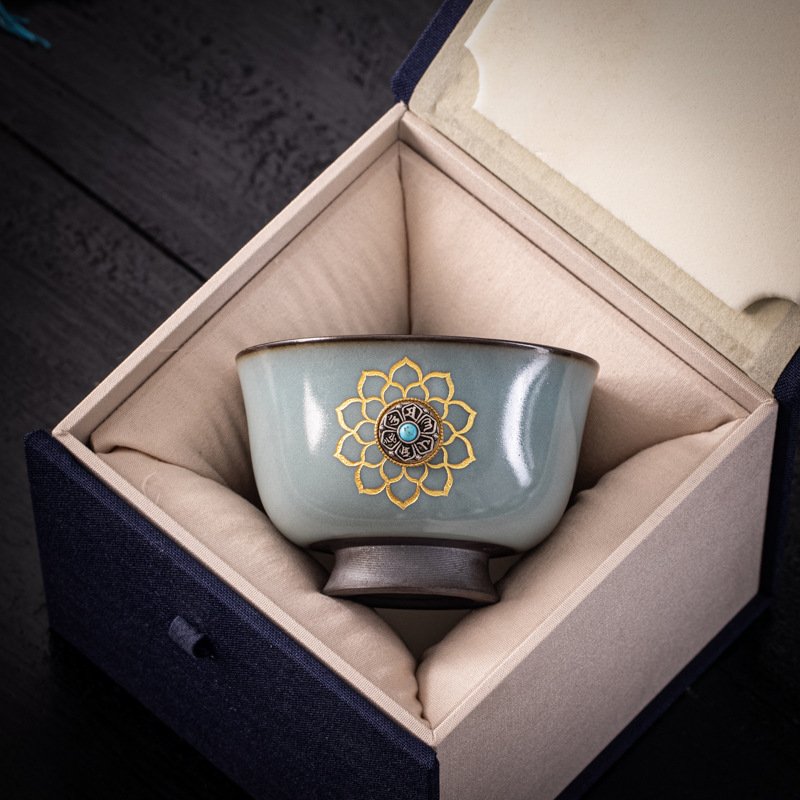I. Origins and Early Forms (Neolithic Era to Shang-Zhou Periods)
- Birth of Proto-Celadon
- The earliest proto-celadon artifacts date back to the late Neolithic period (c. 4200 BCE), such as jars and bowls unearthed at the Dongxiafeng site in Shanxi. Made from porcelain clay coated with plant-ash glaze and fired at ~1200°C, these rudimentary pieces marked the transition from pottery to porcelain despite their coarse texture.
- Technological Advances in Shang-Zhou Dynasties
- Shang Dynasty (c. 1600–1046 BCE): Green-glazed ritual vessels (e.g., the zun vessel in Zhengzhou Museum) featured uneven yellowish-green glaze.
- Western Zhou to Warring States (1046–221 BCE): Improved production techniques yielded denser bodies and intricate carvings, exemplified by the Warring States proto-celadon jar with twin handles in the Palace Museum.
II. Maturation and Development (Eastern Han to Sui-Tang Dynasties)
- Emergence of True Porcelain
- During the Eastern Han Dynasty (25–220 CE), kilns in Shangyu, Zhejiang, produced celadon with fine clay bodies, uniform glaze, and <1% water absorption, marking the birth of true porcelain.
- Regional Specialization
- Three Kingdoms to Northern-Southern Dynasties (220–589 CE): The “southern celadon, northern white porcelain” dichotomy emerged—Yue kiln celadon (lustrous glaze) in the south vs. Xing kiln white porcelain (pure white bodies) in the north, adorned with carved and sculpted patterns.
- Sui-Tang Golden Age (581–907 CE): Yue kiln’s Mise celadon (“jade-like green”) and Xing kiln’s “silver-snow” white porcelain flourished. Tang Sancai (tri-colored lead-glazed pottery) became elite burial staples.
III. Artistic Zenith (Song-Yuan Dynasties)
- Song Dynasty: The Five Great Kilns
- Ru Kiln: Sky-blue glaze (“clear sky after rain”) with cicada-wing crackles.
- Guan & Ge Kilns: Purple-rimmed, iron-footed vessels with golden-thread crackles, celebrating rustic imperfection.
- Jun Kiln: Flambé glazes like “peacock blue” and “rose purple,” famed for unpredictable kiln transmutation (yaobian).
- Ding Kiln: Ivory-white porcelain with intricate incised motifs, pioneering stacked firing for mass production.
- Yuan Innovations
- Blue-and-White Porcelain: Cobalt-blue designs (using imported Sumali pigment) on white bodies, e.g., the Xuande-era pomegranate-shaped vase with lingzhi motifs.
- Dehua Export Whiteware: “Blanc de Chine” figurines and tableware shipped globally via maritime routes, praised by Marco Polo as “Oriental treasures.”
IV. Globalization and Refinement (Ming-Qing Dynasties)
- Ming Official Kilns
- Jingdezhen became the porcelain capital. The Xuande Emperor’s blue-and-white wares (e.g., lingzhi-patterned vases) set technical and aesthetic standards, while Chenghua Doucai combined underglaze blue with overglaze enamels.
- Qing Technical Mastery
- Kangxi-Yongzheng-Qianlong Eras: Innovations like Falangcai (enamel colors), Fencai (soft-hued famille rose), and Langyao Red monochromes flourished under imperial supervision.
- Export Boom: Guangcai (“Canton enamel”) blended Rococo styles for European markets, shipped globally via Manila galleons.
V. Modern Revival and Innovation (20th Century–Present)
- Industrialization: Late Qing-Early Republic reforms introduced mechanized production and chemical glazes.
- Cultural Preservation: Dehua white porcelain and Jingdezhen handcrafting techniques are now intangible cultural heritage. Modern innovations include ultra-thin “paper porcelain” series.
Cultural Significance: Chinese porcelain embodies both technological mastery (high-temperature firing, glaze formulas) and artistic philosophy (symbolic motifs, vessel symbolism), serving as a cornerstone of China’s cultural legacy.
